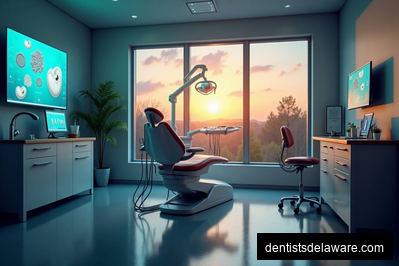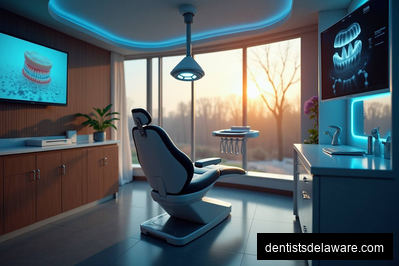Introduction
The dental industry is evolving rapidly, thanks to advancements in technology. These tech trends are not only transforming dental practices but also improving patient experiences. Interestingly, Delaware has emerged as a forerunner in adopting these trends, setting benchmarks for other states to follow.
This blog post will delve into the top trends in dental technology and explore how Delaware is leading the charge. From digital impressions to AI-driven diagnostic tools, we'll discuss the most innovative technologies reshaping the dental industry.
As we delve deeper into this Introduction, it's fascinating to see how technological advancements are reshaping the landscape of the dental industry. From 3D printing of dental implants to AI-powered diagnostic tools, these innovations are revolutionizing the way dentists operate and patients receive care. Imagine a scenario where a dental clinic utilizes virtual reality to educate patients about procedures, creating a more interactive and engaging experience. This dynamic shift not only enhances efficiency but also improves patient outcomes and overall satisfaction. The future of dentistry is undoubtedly bright, as these cutting-edge technologies continue to push boundaries and redefine the standard of care.
Digital Impressions and 3D Printing
Traditional dental impressions have been replaced by digital impressions, which provide more precise and comfortable experiences for patients. Delaware's dental clinics, such as Dover's Dental Associates, have led the way in adopting this technology, ensuring accurate and efficient results.
In tandem, 3D printing technology has revolutionized dental prosthetics, from crowns to implants. Delaware Tech, for instance, has incorporated 3D printing into their dental hygiene program, preparing future dental professionals for this technology-driven era.
While digital impressions have revolutionized dentistry, the integration of 3D printing technology has taken precision and efficiency to new heights. Imagine a scenario where a patient's digital impression is seamlessly transferred to a 3D printer, which then fabricates a custom dental restoration within hours. This streamlined process not only reduces the turnaround time for patients but also minimizes the margin of error that can occur with traditional methods. Furthermore, 3D printing allows for the creation of intricate dental structures that were previously challenging to achieve manually, enabling dentists to offer patients personalized solutions with unparalleled accuracy.
Teledentistry
Teledentistry is another significant trend that has gained momentum, especially amidst the pandemic. It involves providing dental care, advice, or treatment remotely, using digital communication tools. Delaware's Christiana Care Health System is a prime example, offering virtual dental consultations to reach patients regardless of their location.
While teledentistry makes dental care more accessible, it may not replace in-person visits entirely. Some procedures require physical intervention. However, for consultations and follow-ups, teledentistry seems to be a promising solution.
Teledentistry's impact goes beyond convenience; it has revolutionized patient access to dental care in remote areas. Through virtual consultations, dentists can remotely diagnose oral health issues, provide treatment recommendations, and even prescribe medication when necessary. This has been especially beneficial for individuals with limited mobility or those residing in underserved communities. Additionally, teledentistry has enhanced preventive care efforts by enabling real-time monitoring of dental conditions through digital imaging and video consultations. These technological advancements not only improve patient outcomes but also facilitate more efficient communication between dental professionals and their patients.
AI-Driven Diagnostic Tools
Artificial Intelligence (AI) is slowly but surely making its way into the dental industry. AI-driven diagnostic tools can analyze dental images to identify potential issues, ensuring early intervention. Delaware's Nemours Children's Dental Clinic has begun integrating AI-based systems into their practice, improving the accuracy of diagnoses and treatments.
The use of AI in dentistry shows immense promise. However, it's important to note that these technologies are meant to assist dentists, not replace them. Human expertise and judgment remain crucial in dental care.
Artificial Intelligence (AI) is revolutionizing the field of diagnostics in dentistry through innovative AI-driven diagnostic tools. These tools can analyze X-rays with incredible precision, detecting minute details that human eyes might miss. For instance, AI algorithms can assist in identifying early signs of periodontal disease or cavities that are not yet visible to the naked eye. By leveraging machine learning capabilities, these tools can provide dentists with accurate and timely information, leading to quicker diagnosis and more effective treatment plans. As AI continues to advance, we can expect these diagnostic tools to play an increasingly vital role in improving patient outcomes and enhancing the overall quality of dental care.
Laser Dentistry
Laser dentistry is another trend transforming dental procedures. It's used in treating tooth decay, gum disease, and teeth whitening. Delaware's Star Dental has embraced this technology, offering patients a less invasive and more comfortable treatment option.
Laser dentistry is lauded for its precision and reduced recovery time. However, the cost can be higher than traditional procedures. Therefore, it's essential to discuss these factors with patients before opting for this technique.
In the realm of laser dentistry, the advancements are truly fascinating. Beyond just treating tooth decay and gum issues, lasers are now being utilized for precise surgical procedures, like gum reshaping and root canal sterilization. What's remarkable is the reduced need for anesthesia and the minimal bleeding associated with laser treatments. Patients are experiencing quicker recovery times and less discomfort during and after procedures. Moreover, lasers have shown promise in detecting cavities in their early stages, allowing for proactive and preventive dental care. The future of laser dentistry holds immense potential in revolutionizing the way we approach oral health.
Conclusion
Technology continues to reshape the dental industry, offering both challenges and opportunities. Delaware has shown exceptional initiative in adopting these trends, redefining dental care standards. However, it's crucial to remember that technology should augment human expertise, not replace it.
As we move forward, it's exciting to imagine what the future holds for dental care technology. With Delaware leading the way, we can expect to see more innovations that will enhance patient experiences and improve oral health outcomes.
In conclusion, the evolving landscape of dental technology presents a dual reality for practitioners. On one hand, advancements such as 3D printing and intraoral scanners streamline processes and enhance precision in treatments, promising improved patient outcomes. Conversely, the rapid pace of technological innovation poses challenges in terms of continual training and investment to stay current. For instance, adopting new software for patient management may require staff retraining and adjustments to workflow. As the industry pushes forward, dentists must navigate these contrasts to leverage technology effectively while maintaining patient care standards.









